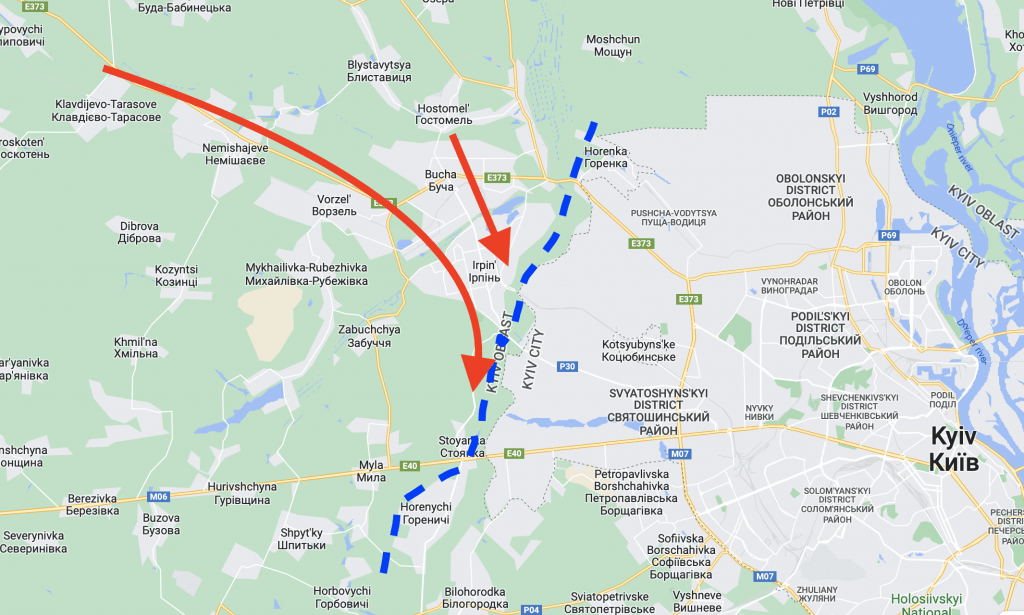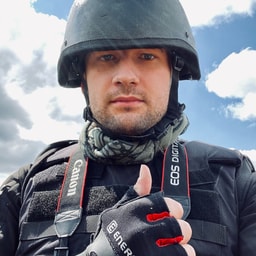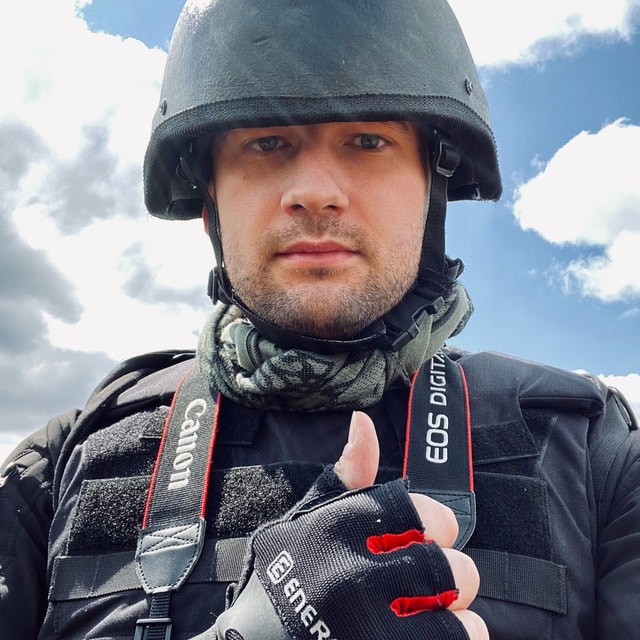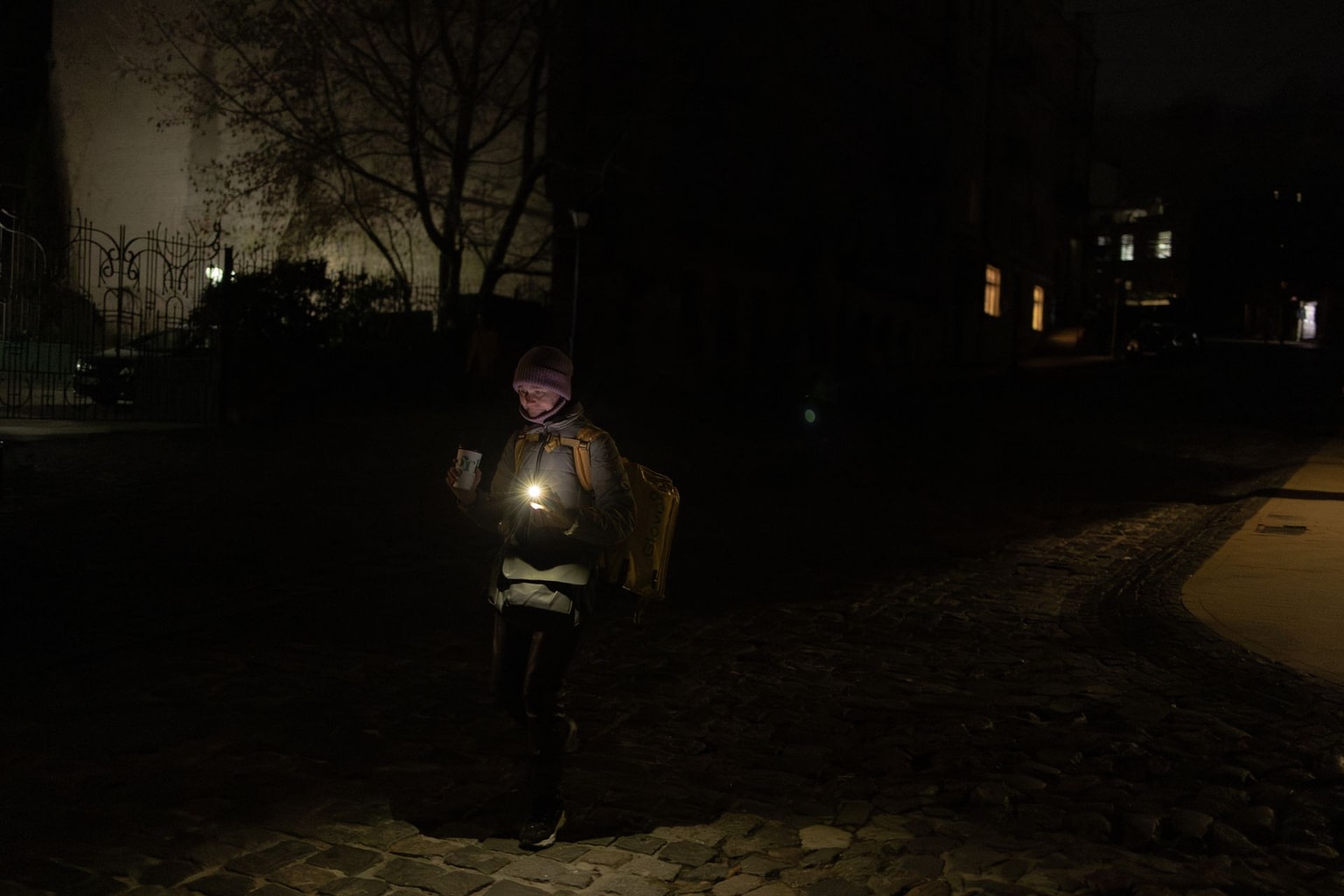Civilians flee in terror as Ukraine’s military deter Russia in Irpin

IRPIN, Ukraine — Hundreds of terrified people cautiously walk through the debris of concrete and twisted metal, trying to cross the Irpen River on foot.
“Come on, no need to rush, careful,” a Ukrainian soldier says while helping civilians onto concrete blocks leading to a stairway.
Mothers hold up their crying babies, young men drag their bicycles, and elderly people carry bags of essentials. Ukrainians and foreigners, all fleeing a brutal war that came in its full destructive power in just a snap.
The rolling thunder sound of heavy fighting reaches from the north.
This messy water crossing used to be a bridge connecting Kyiv and Irpin, a satellite city of 60,000 people just northwest of Ukraine’s capital.
Only 10 days earlier, Irpin was a blossoming, comfortable suburb booming with housing developments.
Now, along with nearby cities of Hostomel and Bucha, it is one of the worst hotspots of Russia’s full-fledged invasion of Ukraine that was unleashed on Feb. 24.
The bridge is in shambles after being blown up by Ukrainian forces in an attempt to slow the approach of Russian forces.
One of the final frontiers of deterring the enemy advance to the heart of the capital city, it is at the same time the only way for many to flee on foot.
Having full control of Irpin is essential for the advancing Russian forces as part of their drive to gain a foothold in Kyiv’s outskirts.
The next step for Russians is to make it to the defunct E40 road, the so-called Zhytomyr Highway that runs just south of Irpin, and then continue their efforts to encompass Kyiv from the west.
So far, this ax remains Russia’s top priority in war after over 10 days of fierce fighting and the enemy’s failure to seize or at least surround Ukraine’s capital in a blitz operation.
Despite the blitzkrieg failure and thousands of casualties in what is becoming a brutal protracted war in an extremely hostile environment, Russian dictator Vladimir Putin did not wave the invasion force off.
Instead, the Kremlin continues claiming that the "special military operation" against Ukraine runs as scheduled and will be completed when the current leadership headed by President Volodymyr Zelensky is overthrown.
In fact, as Ukraine's military reports over 11,000 Russian military casualties after 10 days of the war, this means Russia continues trying to seize Kyiv at any price.
What is more essential for Russians is to keep hold of the Kyiv Oblast highways running northwest, to the Belarus border across the Chornobyl Exclusion Zone. Thousands of Russian vehicles have now been stretched in what is essentially a giant traffic jam tens of kilometers long through Kyiv Oblast.
In this new phase of the Russian invasion, Moscow has been indiscriminately attacking civilians in total defiance of the laws of war.
Since the early days of March, the key road junctions northwest of Kyiv, including Irpin, Hostomel, and Bucha are essentially one giant battlefield in the middle of a densely populated urban area.

The war took these quiet suburbs by surprise. Something that had been raging on for almost eight years in Donbas, more than 600 kilometers away, suddenly came in full terror so close to Ukraine’s very heart.
The situation in the area is deteriorating very quickly.
As recently as March 3-4, Ukrainian forces reported successful operations in Bucha and Hostomel, and even raised the Ukrainian flag over Bucha’s city administration building.
But by March 5, Ukrainian troops have been driven back to Irpin’s northern outskirts. And despite fierce Ukrainian resistance, Russian forces managed to enter the city again and advanced farther to the town of Stoianka close to the E-40.
Late on March 5, a Russian convoy in Stoianka was destroyed, according to the Ukrainian authorities. Nonetheless, fighting for the tight lane connecting Irpin and the Zhytomyr Highway continued in full rage.

"Those towns to the northwest along the Warsaw Highway, many of them do not exist anymore," says a paratrooper taking care of a DShK machine gun mounted on a U.S.-provided Humvee vehicle.
"Razed to the ground amid fighting. One can only guess what the Kyiv Oblast map will look like after the war.”
So people flee.
They flee by their cars packed to the full, bringing out all they can, and crossing the destroyed bridge by foot.
Civilian volunteers marking their cars with signs “Children” and “Evacuation” shuttle between the city and the bridge in the hope to rescue as many as possible.
On their way back to Irpin were vehicles full of smiling Ukrainian soldiers holding on to their rifles and NLAW tank killers provided by the United Kingdom.

As of March 4, the streets of Irpin were almost totally empty but still almost intact. Some civilians even preferred to stay in the city, standing in long queues for food and medicine at stores.
The sounds of heavy fighting, however, were getting closer from the north. Yet another artillery duel between Ukrainian and Russian forces is in full throttle.
As groups of Territorial Defense fighters marked by yellow armlets gather together at a local tiny coffee shop, probably the last of its kind, they pay little attention to the sough of incoming shelling.
A young man, also with a home guard armlet, cycles to the crowd at an insane speed.
“Good god, it’s just a complete nightmare,” he jumps off his bicycle breathing heavily. He is shocked, his eyes goggled.
“We need to speed up the civilian evacuation.”
Bucha, Irpin, and Hostomel are crying for help and evacuation.
According to messages coming from their local authorities, the cities have been badly damaged in the fighting, with hundreds, if not thousands, of civilians, trapped in basements not able to flee.
Despite numerous calls, Russia has not agreed to provide safe civilian passages.
In Irpin, thousands of women and children gathered at the city railway station, in an attempt to take an evacuation train. On March 5, Russia bombed a railway track leading to Kyiv, effectively cutting the way out off.
Meanwhile, the Ukrainian emergency service personnel continued evacuating civilians to the destroyed bridge at the city’s southern outskirt as Russia seized most of Irpin.

By the afternoon of March 6, at least 200 civilians, including 50 children, have been taken to a safe place outside the city.
Nonetheless, even the passage through the Irpin bridge, turned into a nightmare as Russian forces came closer.
On March 6 at noon, Russians shelled the passage while it was full of civilians. According to reports from the ground, a family of four, including two children, was killed. In total, at least eight civilians were killed in Irpin on March 6 alone, according to mayor Oleksandr Markushyn.
The Ukrainian forces will again attempt to evacuate Irpin residents in the morning of March 7.
But as Russians continue to refuse evacuation corridors, there is still no guarantee of getting out of the city safely.










